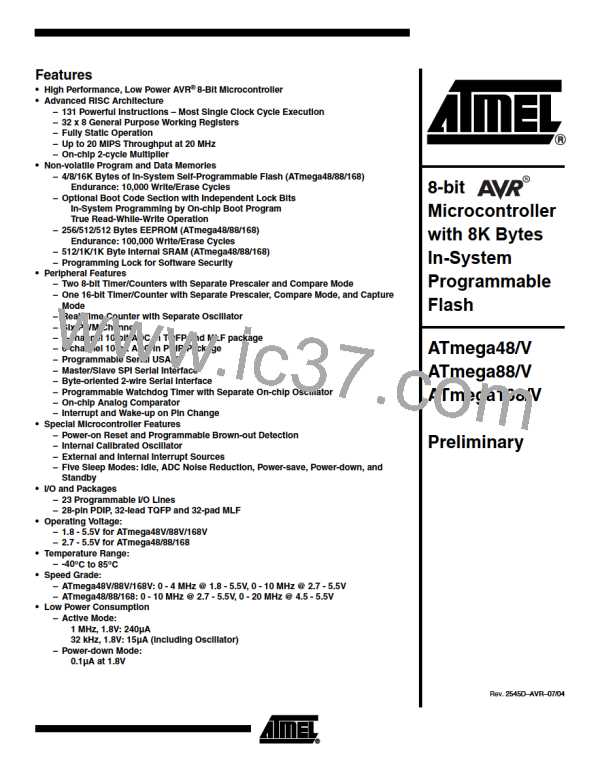Asynchronous Clock
Recovery
The clock recovery logic synchronizes internal clock to the incoming serial frames. Fig-
ure 74 illustrates the sampling process of the start bit of an incoming frame. The sample
rate is 16 times the baud rate for Normal mode, and eight times the baud rate for Double
Speed mode. The horizontal arrows illustrate the synchronization variation due to the
sampling process. Note the larger time variation when using the Double Speed mode
(U2Xn = 1) of operation. Samples denoted zero are samples done when the RxDn line
is idle (i.e., no communication activity).
Figure 74. Start Bit Sampling
RxD
IDLE
START
BIT 0
Sample
(U2X = 0)
0
0
1
1
2
3
2
4
5
3
6
7
4
8
9
5
10
11
6
12
13
7
14
15
8
16
1
1
2
3
Sample
(U2X = 1)
0
2
When the clock recovery logic detects a high (idle) to low (start) transition on the RxDn
line, the start bit detection sequence is initiated. Let sample 1 denote the first zero-sam-
ple as shown in the figure. The clock recovery logic then uses samples 8, 9, and 10 for
Normal mode, and samples 4, 5, and 6 for Double Speed mode (indicated with sample
numbers inside boxes on the figure), to decide if a valid start bit is received. If two or
more of these three samples have logical high levels (the majority wins), the start bit is
rejected as a noise spike and the Receiver starts looking for the next high to low-transi-
tion. If however, a valid start bit is detected, the clock recovery logic is synchronized and
the data recovery can begin. The synchronization process is repeated for each start bit.
Asynchronous Data Recovery When the receiver clock is synchronized to the start bit, the data recovery can begin.
The data recovery unit uses a state machine that has 16 states for each bit in Normal
mode and eight states for each bit in Double Speed mode. Figure 75 shows the sam-
pling of the data bits and the parity bit. Each of the samples is given a number that is
equal to the state of the recovery unit.
Figure 75. Sampling of Data and Parity Bit
RxD
BIT n
Sample
(U2X = 0)
1
1
2
3
2
4
5
3
6
7
4
8
9
5
10
11
6
12
13
7
14
15
8
16
1
1
Sample
(U2X = 1)
The decision of the logic level of the received bit is taken by doing a majority voting of
the logic value to the three samples in the center of the received bit. The center samples
are emphasized on the figure by having the sample number inside boxes. The majority
voting process is done as follows: If two or all three samples have high levels, the
received bit is registered to be a logic 1. If two or all three samples have low levels, the
received bit is registered to be a logic 0. This majority voting process acts as a low pass
filter for the incoming signal on the RxDn pin. The recovery process is then repeated
until a complete frame is received. Including the first stop bit. Note that the Receiver only
uses the first stop bit of a frame.
176
ATmega48/88/168
2545D–AVR–07/04

 ATMEL [ ATMEL ]
ATMEL [ ATMEL ]